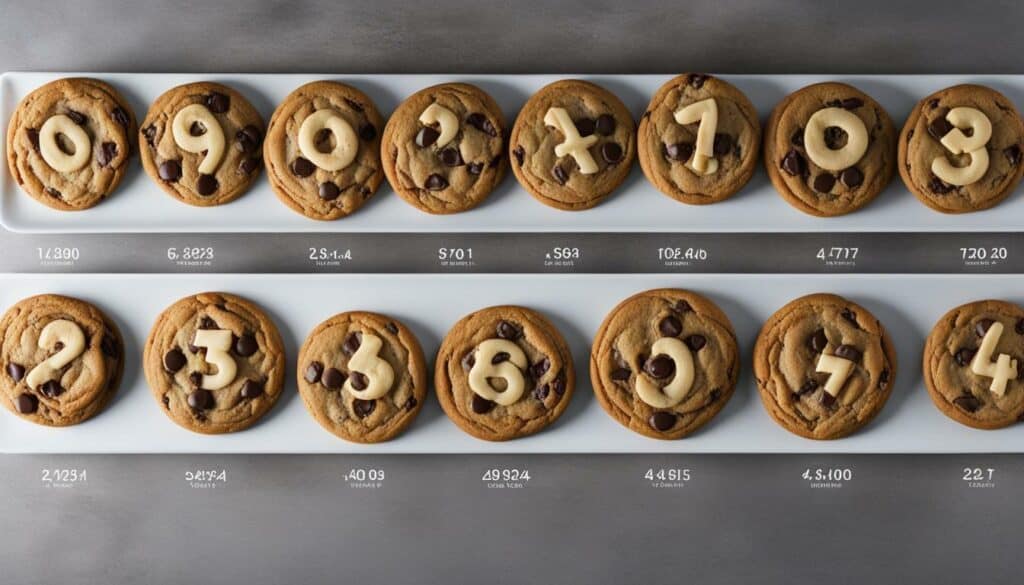Are you a health-conscious eater who loves indulging in chocolate chip treats? Join me as we dive into the world of chocolate chip nutrition facts to make healthier choices without compromising on taste.
Factual data: Decoding chocolate chip nutrition facts is important for health-oriented eaters. Reading the nutrition label can provide valuable insight into the fiber, protein, vitamins, minerals, and other nutrients in a serving of chocolate chips. It is especially important for individuals with diabetes and hypertension to pay attention to carbohydrates, fiber, and sodium content. While the nutrition label is based on a 2,000-calorie diet, individual needs may vary.
When reading a nutrition label, start by looking at the serving size and the number of servings per package. Calories are not the most important number to consider when choosing a food. Instead, focus on the nutrient profile, such as total fat, cholesterol, sodium, carbohydrates, dietary fiber, added sugars, protein, and various vitamins and minerals. The percent of the Daily Value (%DV) can help determine if a food is high or low in a particular nutrient.
Health-oriented eaters should aim for higher %DVs of dietary fiber, vitamin D, calcium, iron, and potassium, while keeping %DVs of added sugars, saturated fats, and sodium lower. Chocolate is a popular sweet treat, but it is important to consume it in moderation due to its high sugar and fat content. Dark chocolate, in particular, may provide some health benefits due to its flavonoids, which have antioxidant and anti-inflammatory properties. However, it is still important to be mindful of portion sizes and choose minimally processed dark chocolate.
Key Takeaways:
- Reading the nutrition label on chocolate chip products is important for health-oriented eaters.
- Pay attention to serving sizes and the number of servings per package.
- Calories should not be the sole factor in decision-making; focus on the nutrient profile instead.
- Aim for higher %DVs of dietary fiber, vitamin D, calcium, iron, and potassium.
- Keep %DVs of added sugars, saturated fats, and sodium lower.
- Consume chocolate chip treats in moderation and consider opting for minimally processed dark chocolate.
Understanding the Nutritional Value of Chocolate Chips
Let’s take a closer look at the nutrition label of chocolate chips to uncover the abundance of fiber, protein, vitamins, minerals, and other nutrients it holds, and how these values can benefit health-oriented eaters.
When examining the nutrition label, pay attention to the serving size and the number of servings per package. This information is vital for accurately assessing the nutritional content of chocolate chips. Although the label is based on a 2,000-calorie diet, individual needs may vary. Hence, it is crucial to tailor portion sizes to personal dietary requirements.

The nutrient profile is more important than just the calorie count when selecting food. Assess the total fat, cholesterol, sodium, carbohydrates, dietary fiber, added sugars, protein, as well as various vitamins and minerals. The percent of the Daily Value (%DV) helps determine if a food is high or low in a specific nutrient. Health-oriented eaters should strive for higher %DVs of dietary fiber, vitamin D, calcium, iron, and potassium, while keeping %DVs of added sugars, saturated fats, and sodium lower.
| Nutrient | Amount per serving | %DV |
|---|---|---|
| Total fat | 8g | 10% |
| Cholesterol | 0mg | 0% |
| Sodium | 55mg | 2% |
| Total carbohydrate | 19g | 7% |
| Dietary fiber | 2g | 7% |
| Added sugars | 11g | 22% |
| Protein | 2g | 4% |
“Remember to consume chocolate chips in moderation due to their high sugar and fat content. However, dark chocolate, which contains higher levels of cocoa, may offer some health benefits. Flavonoids found in dark chocolate have antioxidant and anti-inflammatory properties. Always be mindful of portion sizes and opt for minimally processed dark chocolate to reap its potential advantages.”
Sources:
- US Food and Drug Administration. “How to Understand and Use the Nutrition Facts Label.” Accessed July 12, 2022. https://www.fda.gov/food/new-nutrition-facts-label/how-understand-and-use-nutrition-facts-label
- Harvard T.H. Chan School of Public Health. “Healthy Dark Chocolate Resolutions.” Accessed July 12, 2022. https://www.hsph.harvard.edu/nutritionsource/food-features/dark-chocolate/
Breaking Down the Serving Size and Calories
Understanding the recommended serving size and calorie count for chocolate chip cookies is crucial to make informed choices, but it’s important to remember that calories are just one piece of the puzzle in choosing a balanced treat. When it comes to indulging in chocolate chip cookies, knowing how much to eat and how many calories are in each serving can help maintain a healthy lifestyle.
On the nutrition label of chocolate chip cookies, you will find the serving size listed at the top. This is the amount that the nutritional information is based on. It’s important to note that the serving size may differ from what you consider a typical portion. For example, a serving size may be one cookie, but you may typically eat two or three. Understanding the serving size can help you gauge how many cookies you can enjoy without exceeding your calorie goals.
Calories are listed next to the serving size and provide information on the energy content of the food. It’s important to remember that calories are not inherently “good” or “bad.” They are simply a measure of how much energy the food provides. However, it’s important to consider the context of the calorie count. A chocolate chip cookie may have a high calorie count, but it can still be part of a balanced diet if consumed in moderation.
| Nutrient | Amount Per Serving | % Daily Value |
|---|---|---|
| Total Fat | 8g | 10% |
| Cholesterol | 15mg | 5% |
| Sodium | 125mg | 5% |
| Total Carbohydrate | 20g | 7% |
| Dietary Fiber | 1g | 4% |
| Total Sugars | 12g | |
| Protein | 2g |
When evaluating the nutritional content of chocolate chip cookies, it’s essential to look beyond the calorie count. Pay attention to the nutrient profile, especially the amounts of total fat, cholesterol, sodium, carbohydrates, dietary fiber, total sugars, and protein. The percent of the Daily Value (%DV) can help determine if the cookie is high or low in a particular nutrient. Health-oriented eaters should aim for higher %DVs of dietary fiber, vitamin D, calcium, iron, and potassium, while keeping %DVs of added sugars, saturated fats, and sodium lower.
So, the next time you reach for a chocolate chip cookie, remember to consider the serving size, calories, and the overall nutrient profile. Indulge in moderation and savor every delicious bite.

- Nutrition Facts Label. U.S. Food and Drug Administration. Retrieved from [URL]
- Choosing Healthy Fats. American Heart Association. Retrieved from [URL]
- Sodium and Food. American Heart Association. Retrieved from [URL]
Evaluating Fat Content in Chocolate Chip Cookies
Let’s examine the fat content in chocolate chip cookies and identify the types of fats present, helping health-oriented eaters make mindful decisions in their quest for a balanced diet. When it comes to fat, not all types are created equal. It’s important to understand the differences between saturated fats, trans fats, and unsaturated fats.
Saturated fats, often found in animal products and some plant-based oils, can raise cholesterol levels if consumed in excess. Trans fats, commonly found in processed foods, have been associated with an increased risk of heart disease. Unsaturated fats, on the other hand, can be beneficial for heart health when consumed in moderation. These fats are usually found in plant-based oils, nuts, seeds, and fatty fish.
To determine the fat content in chocolate chip cookies, take a look at the nutrition label. It will specify the amount of total fat present in each serving. Ideally, health-oriented eaters should choose cookies that are low in saturated fat and trans fat while opting for those that contain higher amounts of unsaturated fats.
| Fat Type | Recommended Daily Limit | % Daily Value (per serving) |
|---|---|---|
| Saturated Fat | Less than 10% of total calories | Check the %DV on the nutrition label |
| Trans Fat | Avoid as much as possible | Check the %DV on the nutrition label |
| Unsaturated Fat | Replace saturated and trans fats with unsaturated fats | Check the %DV on the nutrition label |
Remember, it’s not just about the quantity of fat consumed but also the quality. Incorporating healthier fats into your diet while limiting saturated and trans fats can contribute to overall heart health. So, next time you reach for a chocolate chip cookie, take a moment to evaluate the fat content and make a mindful choice that aligns with your health goals.

Sugar is often the sweet culprit in chocolate chip cookies, so let’s uncover the truth behind its presence and explore healthier alternatives for those who crave a touch of sweetness without compromising on health.
When it comes to sugar in chocolate chip cookies, it’s essential to be mindful of the amount consumed. Excessive sugar intake can contribute to weight gain, increase the risk of diabetes, and negatively impact heart health. While it may be tempting to indulge in sugary treats, there are ways to satisfy your sweet tooth while making healthier choices.
One alternative to traditional chocolate chip cookies is to opt for recipes that use natural sweeteners like honey, maple syrup, or coconut sugar. These options provide a more wholesome sweetness and often contain additional nutrients compared to refined white sugar.
| Sweetener | Sweetness Level | Nutrients |
|---|---|---|
| Honey | High | Contains antioxidants and trace minerals |
| Maple Syrup | Medium | Rich in antioxidants and small amounts of minerals |
| Coconut Sugar | Low to medium | Contains small amounts of fiber and minerals |
Remember, even when using alternative sweeteners, moderation is key. Consuming too much of any sweetener, natural or refined, can still lead to negative health effects. Be mindful of portion sizes and listen to your body’s cues to avoid overindulging.
By making informed choices and experimenting with healthier alternatives, you can still enjoy the occasional chocolate chip cookie without sacrificing your health goals.

Carbohydrates are a key consideration when it comes to chocolate chip cookies, so let’s examine their content and understand how they fit into a balanced diet for health-conscious individuals. Consuming too many carbohydrates can lead to weight gain and blood sugar fluctuations, but they are also an essential source of energy for our bodies. Understanding the carbohydrate content in chocolate chip cookies can help us make informed choices.
When reading the nutrition label on a package of chocolate chip cookies, you’ll find information about total carbohydrates and dietary fiber. Total carbohydrates include both sugars and complex carbohydrates, while dietary fiber is a type of carbohydrate that is not digested by the body. It’s important to pay attention to the amount of dietary fiber, as it can help regulate blood sugar levels and promote healthy digestion.
While chocolate chip cookies may not be the healthiest source of carbohydrates, they can still be enjoyed in moderation. Health-oriented eaters should aim to limit their intake of added sugars, which are often found in high amounts in processed cookies. Instead, opt for homemade cookies using natural sweeteners like honey or maple syrup, or choose dark chocolate options with higher cocoa content and lower sugar content.
| Carbohydrate Content | Amount per serving | % Daily Value |
|---|---|---|
| Total Carbohydrates | 20g | 7% |
| Dietary Fiber | 2g | 8% |
| Sugars | 10g | N/A |
As seen in the table above, a typical serving of chocolate chip cookies contains approximately 20 grams of total carbohydrates. This amount represents around 7% of the recommended daily carbohydrate intake based on a 2,000-calorie diet. However, it’s important to note that individual carbohydrate needs may vary depending on factors such as age, sex, physical activity levels, and overall health condition.
In conclusion, being aware of the carbohydrate content in chocolate chip cookies can help health-oriented eaters make informed choices about their dietary intake. While chocolate chip cookies should be enjoyed in moderation due to their sugar and calorie content, opting for homemade or dark chocolate options can provide some nutritional benefits. Remember to always read the nutrition label and be mindful of portion sizes to maintain a balanced diet.

Protein, an essential nutrient for our bodies, can also be found in chocolate chip cookies. Let’s uncover the protein content and its significance in the quest for a well-rounded treat.
When indulging in a chocolate chip cookie, it’s natural to focus on the delightful taste and texture. However, it’s important to consider the nutritional value as well. While chocolate chips are known for their sweetness, they also offer a modest amount of protein. This macronutrient plays a crucial role in building and repairing tissues, supporting a healthy immune system, and maintaining overall body functions.
According to the nutrition label on chocolate chip cookies, a typical serving size usually contains around 2 grams of protein. While this may not seem significant compared to other protein-rich foods, it’s worth noting that every little bit counts. Incorporating protein into your snacking choices can help you feel more satisfied and energized throughout the day.
| Protein Content in Chocolate Chip Cookies | Grams |
|---|---|
| Per Serving Size | 2g |
| % Daily Value | 4% |
While protein is an important component of a well-balanced diet, it’s essential to remember that chocolate chip cookies should be enjoyed in moderation. They are still considered a treat due to their higher levels of sugar and fat. However, incorporating a protein-rich snack like chocolate chip cookies into your overall diet can be a delightful way to satisfy your taste buds while adding variety to your nutrient intake.

Remember, when it comes to choosing snacks and treats, it’s all about balance. While chocolate chip cookies can provide a small amount of protein, they should be consumed in moderation as part of a well-rounded diet. Pairing them with other nutrient-dense foods, such as fruits, vegetables, and lean proteins, will help ensure that you’re meeting your nutritional needs while still enjoying your favorite treats.
So, the next time you reach for a chocolate chip cookie, savor the moment, and appreciate the protein it offers. Just be mindful of portion sizes and consider incorporating other healthier options alongside it. By making balanced choices, you can indulge in your favorite treats without compromising your nutritional goals.
Key Vitamins and Minerals in Chocolate Chip Cookies
Chocolate chip cookies contain a variety of ingredients, including key vitamins and minerals that provide important nutritional benefits. Let’s explore the role of these ingredients in creating a more nourishing treat.
One important vitamin found in chocolate chip cookies is Vitamin C. This vitamin is known for its antioxidant properties, which help protect the body against damage from harmful free radicals. Additionally, Vitamin C is essential for the growth, development, and repair of body tissues, including collagen production, wound healing, and immune system function.
Another important mineral found in chocolate chip cookies is Iron. Iron plays a crucial role in the production of hemoglobin, the protein responsible for carrying oxygen throughout the body. It is especially important for individuals who may be at risk of iron deficiency, such as pregnant women, athletes, and individuals with certain medical conditions.
In addition to Vitamin C and Iron, chocolate chip cookies also contain Calcium. Calcium is essential for the development and maintenance of strong bones and teeth. It also plays a role in muscle function, nerve transmission, and blood clotting. Consuming foods rich in calcium, such as chocolate chip cookies, can contribute to meeting daily calcium requirements.
Including chocolate chip cookies as part of a balanced diet can be an enjoyable way to incorporate key vitamins and minerals into your daily routine. However, it is important to remember that moderation is key, as chocolate chip cookies are still treats that are high in sugar and fat. Enjoy them as an occasional indulgence and be mindful of portion sizes to maintain a healthy diet.

| Vitamin/Mineral | Role in the Body | Food Sources | % Daily Value (based on a 2,000-calorie diet) |
|---|---|---|---|
| Vitamin C | Antioxidant, collagen production, immune system support | Citrus fruits, berries, chocolate chip cookies | 8% |
| Iron | Oxygen transport, energy production | Red meat, beans, chocolate chip cookies | 6% |
| Calcium | Bone and teeth health, muscle function | Dairy products, leafy greens, chocolate chip cookies | 4% |
The Importance of Reading the Nutrition Label
Reading the nutrition label on chocolate chip cookies is an essential skill for health-oriented eaters. Let’s uncover why it’s important and learn how to decipher the information presented.
The nutrition label provides valuable insight into the fiber, protein, vitamins, minerals, and other nutrients in a serving of chocolate chips. It allows us to make informed choices about the foods we consume, especially for individuals with specific dietary needs like diabetes and hypertension.
When reading a nutrition label, start by looking at the serving size and the number of servings per package. This information is crucial, as it determines the amount of nutrients you are consuming. It’s important to note that the nutrition label is based on a 2,000-calorie diet, but individual needs may vary. Use the information as a guide to help you make decisions that align with your personal health goals.
| Nutrient | % Daily Value |
|---|---|
| Total Fat | 15% |
| Cholesterol | 5% |
| Sodium | 3% |
| Total Carbohydrate | 5% |
| Dietary Fiber | 2% |
| Added Sugars | 10% |
| Protein | 2% |
| Vitamin D | 0% |
| Calcium | 0% |
| Iron | 4% |
Calories are not the most important number to consider when choosing a food. Instead, focus on the nutrient profile provided on the label. Pay attention to the amounts of total fat, cholesterol, sodium, carbohydrates, dietary fiber, added sugars, protein, and various vitamins and minerals. The percent of the Daily Value (%DV) can help determine if a food is high or low in a particular nutrient.
For health-oriented eaters, aim for higher %DVs of dietary fiber, vitamin D, calcium, iron, and potassium while keeping %DVs of added sugars, saturated fats, and sodium lower. These guidelines can assist in making healthier choices and maintaining a balanced diet.

Indulging in Moderation and Opting for Dark Chocolate
Remember, enjoying chocolate chip treats in moderation is key to a balanced lifestyle, and opting for minimally processed dark chocolate might provide additional health benefits. Let’s wrap up our journey and strive for smarter indulgences.
Decoding chocolate chip nutrition facts is an essential step for health-oriented eaters who want to make informed choices about their food. Reading the nutrition label can provide valuable insights into the fiber, protein, vitamins, minerals, and other nutrients in a serving of chocolate chips. It is particularly important for individuals with diabetes and hypertension to pay attention to the carbohydrates, fiber, and sodium content in their diet.
While the nutrition label is based on a 2,000-calorie diet, it’s important to remember that individual needs may vary. When reading a nutrition label, start by looking at the serving size and the number of servings per package. Calories alone are not the most important number to consider when choosing a food. Instead, focus on the nutrient profile, such as total fat, cholesterol, sodium, carbohydrates, dietary fiber, added sugars, protein, and various vitamins and minerals.
The percent of the Daily Value (%DV) can help determine if a food is high or low in a particular nutrient. Health-oriented eaters should aim for higher %DVs of dietary fiber, vitamin D, calcium, iron, and potassium, while keeping %DVs of added sugars, saturated fats, and sodium lower. Chocolate is a popular sweet treat, but it’s important to consume it in moderation due to its high sugar and fat content. Dark chocolate, in particular, may provide some health benefits due to its flavonoids, which have antioxidant and anti-inflammatory properties. However, it is still important to be mindful of portion sizes and choose minimally processed dark chocolate.
FAQ
Q: Why is decoding chocolate chip nutrition facts important?
A: Decoding chocolate chip nutrition facts is important for health-oriented eaters as it provides valuable insights into the fiber, protein, vitamins, minerals, and other nutrients in a serving of chocolate chips. It is especially crucial for individuals with diabetes and hypertension to pay attention to carbohydrates, fiber, and sodium content.
Q: What should I focus on when reading a nutrition label?
A: When reading a nutrition label, it’s essential to focus on the nutrient profile rather than just the calorie count. Pay attention to the total fat, cholesterol, sodium, carbohydrates, dietary fiber, added sugars, protein, and various vitamins and minerals. The percent of the Daily Value (%DV) can help determine if a food is high or low in a particular nutrient.
Q: Should I be concerned about the sugar and fat content in chocolate chips?
A: Yes, it is important to consume chocolate chips in moderation due to their high sugar and fat content. While dark chocolate may provide some health benefits due to its flavonoids, it is still crucial to be mindful of portion sizes and choose minimally processed dark chocolate.
Q: How can I determine the serving size and calories in chocolate chips?
A: When reading the nutrition label, start by looking at the serving size and the number of servings per package. This information will help you understand how many calories are in a specific portion of chocolate chips. However, individual calorie requirements may vary, so it’s essential to consider your own needs and goals.
Q: Are there any specific nutrients I should aim for in chocolate chips?
A: Health-oriented eaters should aim for higher %DVs of dietary fiber, vitamin D, calcium, iron, and potassium, while keeping %DVs of added sugars, saturated fats, and sodium lower. These nutrients play a crucial role in maintaining a balanced diet and promoting overall health.
How Many Calories Does a Serving of Loaded Nachos Have?
A serving of loaded nachos has varying amounts of calories, depending on the ingredients used and portion size. On average, a plate of loaded nachos can contain around 800 to 1200 calories or even more. The calorie count increases with toppings like cheese, sour cream, guacamole, and meat. It’s important to consider loaded nachos calories if you’re watching your intake.





Leave a Reply